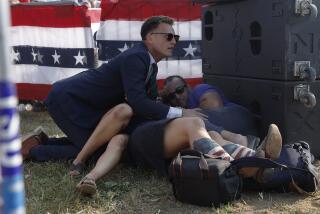For real snipers, serial killings make a tough job tougher
- Share via
With the arrests Wednesday of John Allen Muhammad and Lee Boyd Malvo in connection with the 13 shootings in the suburbs of Washington, D.C., the country breathed a collective sigh of relief.
But for some, Muhammad’s arrest brought a new worry. The community of professional snipers -- highly trained military personnel and law enforcement officers -- feared the suspect’s military background would contribute to the distorted image of their profession.
“We’re deemed to be evil,” said Carl Taylor, a former Marine sniper and co-founder of Surgical Shooting Inc., a training school in San Diego. “Snipers are the bastard children of the military community. Everybody hates you.”
Army personnel records show that Muhammad had no affiliation with sniper or special forces. Nevertheless, his military background “is going to make life harder for us,” Taylor said. “We fought this battle over the decades, and every time some crackpot with a gun goes out there and shoots rounds, they call him a sniper.”
All soldiers entering the Army undergo basic training with M-16 rifles. Once every year, they have to requalify, earning “marksman,” “sharpshooter” or “expert” marks. Muhammad ultimately earned only a sharpshooter mark, so to compare him to a military sniper would be inaccurate, said Robert Castelli, who teaches at John Jay College of Criminal Justice in New York. “The analogy is playing for the varsity basketball team as opposed to the NBA,” he said.
The arrests capped a month in which professional snipers distanced themselves not only from the shootings, but also from civilian sniper enthusiasts.
“It has brought a lot of attention to the sniper community,” said Derrick Bartlett, president of the American Sniper Assn. and a SWAT sniper for the Fort Lauderdale Police Department in Florida. “For over 30 years police snipers have labored in silence, saving lives. Now, people are suddenly wanting to talk.”
On the association’s Web site, Bartlett recently posted a “Letter to the Media,” detailing the group’s official position:
“The individual responsible for the string of killings in the D.C. area is not a sniper.... He is a serial killer who is using a rifle to indiscriminately kill innocent civilians....
“We recognize the existence of the so-called sniper subculture. We know about the groupies, wannabes and enthusiasts to whom this is a hobby and a weekend fantasy. For the trained professionals we represent, this is our job. We do not take this lightly.”
“The people who are involved in this, they’re not demons of darkness ... or unemotional killing machines -- that’s not it,” said Roy Huntington, a former San Diego police officer and editor of American Handgunner, a magazine for firearms enthusiasts. Snipers “do this really dirty job for the rest of us.”
And pulling the trigger is a cause for neither bragging nor celebration, Huntington said. It’s a failure. “That they had to pull the trigger means negotiations, or something else, failed. It’s truly last resort,” he said. The informal sniper motto is “One shot, one kill.” To a subculture of aficionados, slogans like that and “Reach out and touch someone” fuel the sniper myth and are worn on T-shirts. Sniping has been glorified in video games such as Counter Strike and Silent Scope and in movies such as “Sniper” (1993), starring Tom Berenger. There are other stars too: Marine Gunnery Sgt. Carlos Hathcock II, one of the most effective snipers of the Vietnam War with 93 confirmed kills, has attained mythic status.
“They want to rub elbows with us,” Bartlett said. “Something else in their lives doesn’t gel, so they love the fantasy and playing the game.” The fantasy is so prevalent that several Web sites, such as www.phonysnipers.com, are dedicated to exposing the poseurs.
“There has been a literal explosion of literature, pamphlets, videos and Web sites that ... glorify the sniper culture and the job that professional snipers do,” said Tom Diaz, a senior policy analyst at the Washington-based Violence Policy Center, a gun-control advocacy group.
On the Sniperworld Web site, banners advertise Russian sniper scopes. Eric’s Sniper Page offers a step-by-step guide to sewing your own camouflage suit, called a ghillie suit. And the how-to video “Ultimate Sniper” is, according to its promotional material, “crammed with information on the three great sniping skills areas: Marksmanship, Tactics and Fieldcraft.”
In a 1999 report titled “One Shot, One Kill,” Diaz warned that as the gun market became saturated, some manufacturers found that military and police sniper rifles were among the few growth areas and increasingly turned their attention to selling them to civilians. And for those interested in practicing their precision-shooting skills, some schools, such as Storm Mountain Training School in West Virginia, offer civilians classes in sniping, including elements of stalking and concealment -- neither of which has a sports application, Diaz said.
“I can’t think of any reason why a private citizen needs to learn sniper skills,” Bartlett said. But the 18-year veteran understands the allure of the sniper myth. “Every time we’re depicted in the movies, it’s the lone wolf -- the man who’s defiant to authority and outside the law,” he said. “But that’s not the way we work. If people saw how we work, they’d be bored.”
More to Read
Sign up for Essential California
The most important California stories and recommendations in your inbox every morning.
You may occasionally receive promotional content from the Los Angeles Times.










